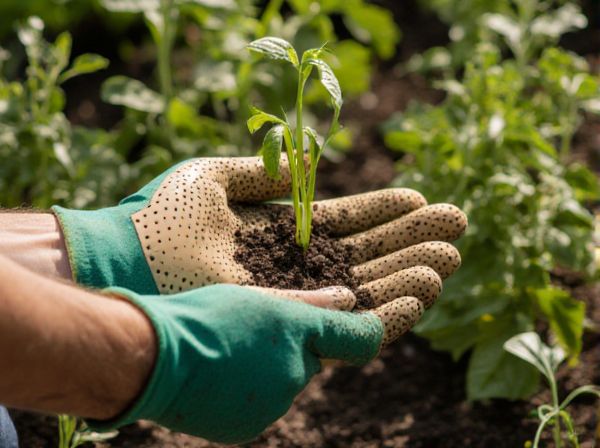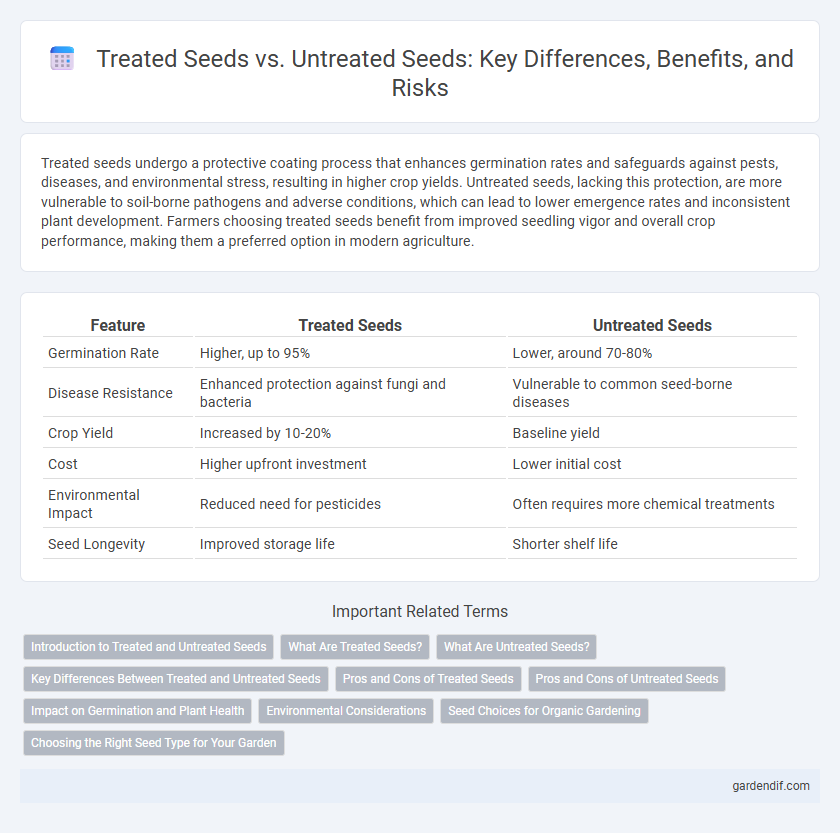
Treated seeds vs Untreated seeds Illustration
Treated seeds undergo a protective coating process that enhances germination rates and safeguards against pests, diseases, and environmental stress, resulting in higher crop yields. Untreated seeds, lacking this protection, are more vulnerable to soil-borne pathogens and adverse conditions, which can lead to lower emergence rates and inconsistent plant development. Farmers choosing treated seeds benefit from improved seedling vigor and overall crop performance, making them a preferred option in modern agriculture.
Table of Comparison
| Feature | Treated Seeds | Untreated Seeds |
|---|---|---|
| Germination Rate | Higher, up to 95% | Lower, around 70-80% |
| Disease Resistance | Enhanced protection against fungi and bacteria | Vulnerable to common seed-borne diseases |
| Crop Yield | Increased by 10-20% | Baseline yield |
| Cost | Higher upfront investment | Lower initial cost |
| Environmental Impact | Reduced need for pesticides | Often requires more chemical treatments |
| Seed Longevity | Improved storage life | Shorter shelf life |
Introduction to Treated and Untreated Seeds
Treated seeds undergo specific chemical or biological coatings to protect against pests, diseases, and environmental stress, enhancing germination and crop yield potential. Untreated seeds lack these protective treatments, making them more vulnerable to pathogens and adverse conditions, often requiring additional management practices. Choosing between treated and untreated seeds depends on factors such as crop type, pest pressure, and environmental challenges, impacting overall agricultural productivity.
What Are Treated Seeds?
Treated seeds are seeds that have been coated or infused with chemical or biological substances to protect them from pests, diseases, and environmental stresses during germination and early growth. These treatments enhance seedling vigor, improve crop yields, and reduce the need for additional pesticide applications. Common seed treatments include fungicides, insecticides, and inoculants designed to promote healthier and more resilient plant development.
What Are Untreated Seeds?
Untreated seeds are those that have not been coated or treated with chemical fungicides, insecticides, or herbicides to protect against pests and diseases. These seeds maintain their natural state, making them ideal for organic farming and environments where chemical use is restricted. Farmers often choose untreated seeds to avoid potential chemical residues and to promote sustainable agricultural practices.
Key Differences Between Treated and Untreated Seeds
Treated seeds undergo a coating process with fungicides, insecticides, or biological agents to protect against pests and diseases, enhancing germination rates and crop yield potential. Untreated seeds lack this protective layer, making them more susceptible to environmental stressors, pathogens, and pests, which can result in lower germination success and reduced vigor. The choice between treated and untreated seeds significantly impacts crop management strategies, pest control efficacy, and overall agricultural productivity.
Pros and Cons of Treated Seeds
Treated seeds offer enhanced protection against pests, diseases, and environmental stress, leading to higher germination rates and improved crop yields. However, they can be more expensive and may pose environmental risks due to the chemicals used in seed treatments. Untreated seeds avoid chemical exposure, promoting a more organic approach, but they often face higher vulnerability to pathogens and reduced overall field performance.
Pros and Cons of Untreated Seeds
Untreated seeds retain their natural genetic traits and avoid exposure to chemical treatments, making them ideal for organic farming and preserving biodiversity. However, they are more susceptible to pests, diseases, and poor germination rates, potentially reducing crop yield and increasing the need for manual intervention. These seeds require careful management and may not perform well in environments with high pest pressure or adverse conditions compared to treated seeds.
Impact on Germination and Plant Health
Treated seeds, enhanced with fungicides and insecticides, significantly improve germination rates by protecting seeds from soil-borne pathogens, resulting in robust seedling establishment and healthier plant development. Untreated seeds are more susceptible to diseases and pests, often leading to lower germination success and weakened plants vulnerable to environmental stresses. Investing in treated seeds ensures better crop uniformity and yield potential due to enhanced early growth vigor and reduced seedling mortality.
Environmental Considerations
Treated seeds reduce the need for chemical pesticides, lowering environmental contamination and promoting sustainable agriculture. Untreated seeds might increase pest vulnerability, leading to higher pesticide application and potential harm to soil and water ecosystems. Choosing treated seeds supports integrated pest management and minimizes the ecological footprint of crop production.
Seed Choices for Organic Gardening
Treated seeds often contain chemical coatings that protect against pests and diseases but may not comply with organic gardening standards. Untreated seeds are preferred in organic gardening because they preserve natural seed integrity and avoid synthetic chemicals, supporting healthier soil ecosystems. Selecting untreated seeds ensures adherence to organic certification requirements and promotes sustainable plant growth.
Choosing the Right Seed Type for Your Garden
Treated seeds are coated with fungicides, insecticides, or nutrients to enhance germination and protect young plants from pests and diseases, making them ideal for gardens prone to soil-borne pathogens. Untreated seeds provide a natural option free from chemical coatings, suitable for organic gardening and those seeking to avoid synthetic additives. Selecting between treated and untreated seeds depends on garden conditions, pest pressure, and personal preferences for chemical use and environmental impact.
Treated seeds vs Untreated seeds Infographic

 gardendif.com
gardendif.com